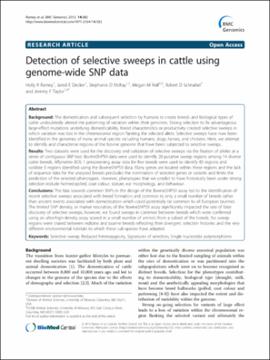| dc.contributor.author | Ramey, Holly R. | |
| dc.contributor.author | Decker, Jared E. | |
| dc.contributor.author | McKay, Stephanie D. | |
| dc.contributor.author | Rolf, Megan M. | |
| dc.contributor.author | Schnabel, Robert D. | |
| dc.contributor.author | Taylor, Jeremy F. | |
| dc.date.accessioned | 2018-11-09T21:10:51Z | |
| dc.date.available | 2018-11-09T21:10:51Z | |
| dc.date.issued | 2013-06-07 | |
| dc.identifier | oksd_ramey_detectionofsele_2013 | |
| dc.identifier.citation | Ramey, H. R., Decker, J. E., McKay, S. D., Rolf, M. M., Schnabel, R. D., & Taylor, J. F. (2013). Detection of selective sweeps in cattle using genome-wide SNP data. BMC Genomics, 14, Article 382. https://doi.org/10.1186/1471-2164-14-382 | |
| dc.identifier.uri | https://hdl.handle.net/11244/302064 | |
| dc.description.abstract | Background: The domestication and subsequent selection by humans to create breeds and biological types of cattle undoubtedly altered the patterning of variation within their genomes. Strong selection to fix advantageous large-effect mutations underlying domesticability, breed characteristics or productivity created selective sweeps in which variation was lost in the chromosomal region flanking the selected allele. Selective sweeps have now been identified in the genomes of many animal species including humans, dogs, horses, and chickens. Here, we attempt to identify and characterise regions of the bovine genome that have been subjected to selective sweeps. | |
| dc.description.abstract | Results: Two datasets were used for the discovery and validation of selective sweeps via the fixation of alleles at a series of contiguous SNP loci. BovineSNP50 data were used to identify 28 putative sweep regions among 14 diverse cattle breeds. Affymetrix BOS 1 prescreening assay data for five breeds were used to identify 85 regions and validate 5 regions identified using the BovineSNP50 data. Many genes are located within these regions and the lack of sequence data for the analysed breeds precludes the nomination of selected genes or variants and limits the prediction of the selected phenotypes. However, phenotypes that we predict to have historically been under strong selection include horned-polled, coat colour, stature, ear morphology, and behaviour. | |
| dc.description.abstract | Conclusions: The bias towards common SNPs in the design of the BovineSNP50 assay led to the identification of recent selective sweeps associated with breed formation and common to only a small number of breeds rather than ancient events associated with domestication which could potentially be common to all European taurines. The limited SNP density, or marker resolution, of the BovineSNP50 assay significantly impacted the rate of false discovery of selective sweeps, however, we found sweeps in common between breeds which were confirmed using an ultra-high-density assay scored in a small number of animals from a subset of the breeds. No sweep regions were shared between indicine and taurine breeds reflecting their divergent selection histories and the very different environmental habitats to which these sub-species have adapted. | |
| dc.format | application/pdf | |
| dc.language | en_US | |
| dc.publisher | BioMed Central | |
| dc.rights | This material has been previously published. In the Oklahoma State University Library's institutional repository this version is made available through the open access principles and the terms of agreement/consent between the author(s) and the publisher. The permission policy on the use, reproduction or distribution of the material falls under fair use for educational, scholarship, and research purposes. Contact Digital Resources and Discovery Services at lib-dls@okstate.edu or 405-744-9161 for further information. | |
| dc.title | Detection of selective sweeps in cattle using genome-wide SNP data | |
| osu.filename | oksd_ramey_detectionofsele_2013.pdf | |
| dc.description.peerreview | Peer reviewed | |
| dc.identifier.doi | 10.1186/1471-2164-14-382 | |
| dc.description.department | Animal Science | |
| dc.type.genre | Article | |
| dc.type.material | Text | |
| dc.subject.keywords | selective sweep | |
| dc.subject.keywords | reduced heterozygosity | |
| dc.subject.keywords | signatures of selection | |
| dc.subject.keywords | single nucleotide polymorphisms | |
